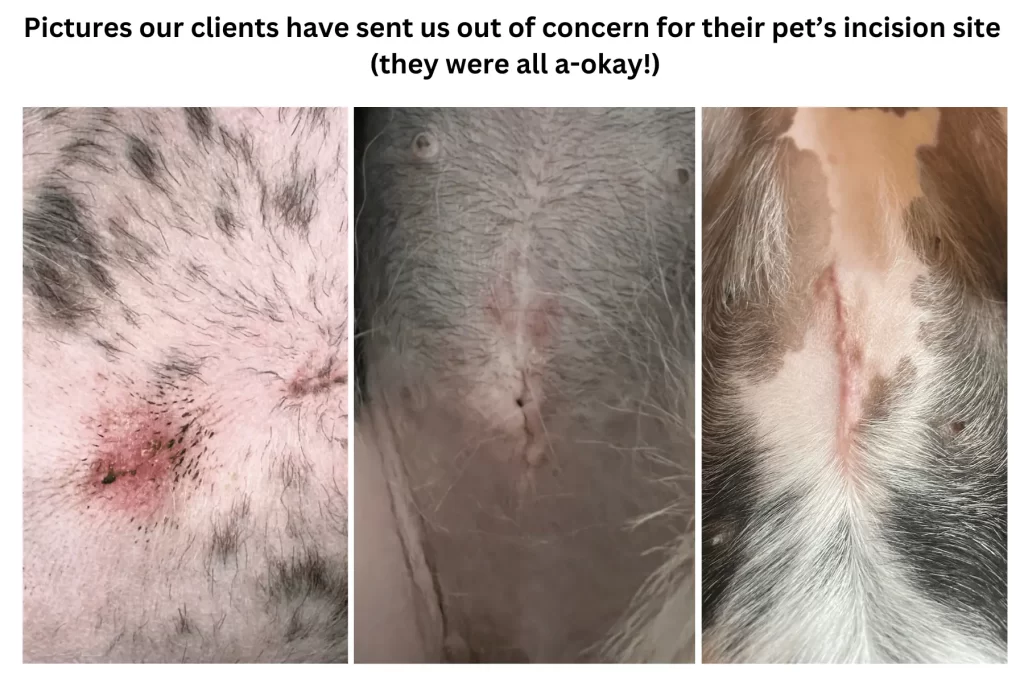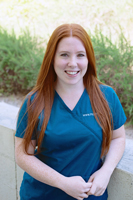If your pet just had surgery, check out this guide created by our Registered Veterinary Technician (and Veterinarian Liaison), Hunter. This guide contains important information to set your pet up for success after general surgery.
This article was transcribed from our Youtube video; so if you’d prefer to watch a video of these after care instructions, click that link.
Please note, this article was intended for our clients, you should always call your veterinarian with specific instructions as things may differ case by case or even state by state.
No Over the Counter Medications
The first thing we always tell our pet parents is not to give any over the counter medications. What we mean is: no Advil, Tylenol, Ibuprofen. Those kinds of things can actually be really toxic to our pets. So make sure that you’re only giving medications that we have prescribed. Those will be gone over with you on the day of any sort of procedure here.

Keep an Eye on the Incision
We do want you to keep a close eye on the incision. It’s very important that we make sure it stays clean and dry. We want to monitor for anything abnormal which would be: swelling at the surgery site, any sort of discharge. If the incision is opening up at all – if it looks like sutures are coming loose, anything like that – let us know. And if at any point you’re looking at the incision and you’re just not sure if what you’re seeing is normal or not, take a picture of it and send it our way (our email is aliciapetcare@gmail.com). We can typically let you know (as long as it’s a pretty good picture) whether it’s something that’s normal or if we’d like you to bring your pet in.

Expect Your Pet to Be Vocal
Sometimes after anesthesia, our patients might be more vocal than they normally are at home. This means they might whine, cry, howl or do things like that. That is actually very typical after an anesthetic procedure. And most commonly, it’s because of the medications that are given. Some of the pain medications can cause a little bit of dysphoria: a little bit of a “head high” and that can discombobulate our pets a little bit. It’s similar to when humans have their wisdom teeth out and they’re kind of gibbering and being a bit nonsensical afterwards. This is kind of the pet equivalent to that. If we are seeing this at home, it usually resolves within 12 to 24 hours of the anesthesia. As long as your pet seems comfortable otherwise and seems like they’re resting, then it is okay. That is very normal and just wait for that effect to wear off.
Monitor for Vomiting or Diarrhea
Some things we do want you to monitor for after a procedure are vomiting or diarrhea. We do give anti-nausea medication before the procedure and that typically lasts about 24 hours. So we don’t expect any tummy trouble. But if you do see any of those signs, let us know. Another thing that we sometimes see after anesthesia is sometimes our patients might not have a bowel movement right away, post-operation. It may take a few days and that’s very normal. Every pet is different. Some patients are going to go home that night and have a bowel movement, while others just might take a few days. We’re not concerned if it does take a few days. The only time we want you to report to us is if you notice that your pet is going to the bathroom and it looks like they’re straining to go and having a hard time of it. If that’s the case: let us know. Otherwise, just wait for nature to take its course for your pet’s procedure today.
Take off the IV catheter tape on their arm when they get home
Your pet likely had an IV catheter placed in one of their front arms. So they will have a small shave mark there when they go home with you today. They might have a little green bandage wrapped around that front arm, too. That is just a pressure bandage from when we take the IV out. Kind of similar to how we would go home with a band aid on our arm after an IV. This should be taken off when you get home. Especially with cats. We always recommend taking it off right when you get home. It’s very common for cats to get home from their day here and their first instinct is to run under the couch or bed and hide from us. So we do want you to make sure to take that bandage off right when you get home with them.
Sutures and Staples
Your pet might be going home with some sutures in, this is extremely common for most of our spays and neuters. Those sutures are going to be internal and are going to dissolve on their own. So those don’t need to be removed. If your pet had another type of surgery like a mass removal or something like that, there may be sutures or staples on the outside that do need to come out in 14 days. We will let you know during your discharge if we do need to see you back for that technician appointment. Otherwise, if we don’t let you know that we need to take those out, they are internal and will dissolve on their own.
Keep the E-collar on 24/7 for 14 days post-op
For most of our procedures, we are going to have our patients go home with an E-collar on and that might be a plastic E-collar, or a comfy cone, or a “donut”. Regardless of the type of cone, we do recommend leaving that on for 14 days post-op. That way, your pet can’t get to their incision. The best recommendation we have for you is to leave that cone on 24/7. This is the way that our pets adjust to them more quickly and it’s the safest so that they don’t have a chance to get to their incisions and cause any harm.
If you do need to take that cone off for any reason – say your pet just can’t figure out how to eat with it on – make sure somebody is watching them. We have seen it happen where pets get a minute to themselves without that cone on and they’ve done damage to their surgery sites. So we do want to make sure that you are being as vigilant as possible with the cone and keeping that on for the full 14 days until everything has healed up.

Limit Activity
Dogs: We do need to limit your dog’s activity after a procedure. In most general surgeries, we do recommend absolute rest for the first 48 hours post-op. If your pet is used to being in a crate and they’re happy in there, it’s a good time to use that to your advantage. Any time that they’re not with you or if you leave the house, pop them in that crate so that we know they’re not up and doing a ton of independent movement. If they’re not used to a crate, we just recommend confining them to one room or area of the house, so they don’t have free reign of the whole home.
After that initial period of absolute rest, we do want to try a minimal movement period for dogs. We recommend minimal movement for about two weeks. We want to prevent jumping up and down off furniture, running around, playing too much. And if you have stairs in the home, we do recommend limiting stair use. If you have a pup that maybe just goes up and down the stairs once or twice a day to go to bed or something like that: that’s okay. As long as they’re doing so in a mellow way. But if you do have a dog that wants to go up and down those stairs a ton throughout the day, you might want to block those stairs off.
The last thing for dogs as far as activity goes is we do want them to be leash-walked ONLY for a full 14 days after surgery. This means we don’t want them to have any time outdoors where they are not on a non-retractable leash. So even if they’re in your own yard, we still recommend throwing a leash on them because you just never know when they’re going to see a squirrel and go to chase it or get the urge to do zoomies or something like that and hurt their incision. So just make sure all outdoor times for two weeks post-op are on a leash.
Cats: With cats, this is a little bit different. We recommend 24 hours of absolute rest with kitties; putting them into one room, like a bathroom or a small bedroom. They shouldn’t have a lot of high places that they can jump up on and climb up on. Cats, though, are a little bit harder to keep down than dogs. So just do your best to keep them still.
For cats, the minimal movement period is typically about a week. What we recommend for them is just any time you see that maybe they’re about to jump up on something, you try to discourage them away with a distraction.
Now with the jumping for both cats and dogs, if you do see it happen, don’t panic. We can only do so much in keeping our pets more mellow. If you do see them jump onto something, just make sure we’re checking those incisions daily. Usually if they’re being too active, their incision might show signs of that. It might appear swollen or things like that. So as long as you’re monitoring that, you’re probably doing a fine job in keeping them mellow.
For cats and dogs, if you do find that you are having a really difficult time keeping them calm, let us know and we can talk about adjusting medications or adding some medications to help them stay relaxed.
Feeding the Night of the Procedure…
For most cases, you can feed your pet the night of the procedure, and you will want to do a small amount that night. We typically recommend feeding half on the night of a procedure just in case they do have some breakthrough nausea. We don’t want you to overload their tummy with food. It’s kind of hit or miss whether pets eat the night of a surgery. Some are ravenous, some eat their whole meal. Some don’t have a ton of interest in it and that’s totally fine. Either way is normal the night of surgery. The next day, they can have their full amount of food again if they want it.
After Care Medications
As far as medications go, we are going to be going over your specific medication names, dosing instructions and everything like that when we call you to let you know that your pet is ready.
Conclusion
Last but not least: if at any point you have concerns about your pet during the healing process, reach out to us. If we aren’t open, our phones automatically will forward to Animal Urgent Care in Mission Viejo, so they are there to help you if you need anything and it’s after hours with us.
We are open 7am to 7pm Monday through Friday, and 7am to 3pm on Saturdays. Our office number is 949-768-1313 and we are located in Mission Viejo, CA.
What Makes us the Best for your Pets?
- Vaccinations
- Integrative Medicine
- Pharmacy
- Surgical Care
- Diagnostic Imaging
- Dentistry
- Pet Boarding
- Grooming
- Laboratory Facilities
About The Author
She is the proud mom of two rescue cats, and the proud mom of her own human child!
Contact Us
Call (949) 768-1313
Fax (949) 768-5759
Address
25800 Jeronimo Road., Suite 100
Mission Viejo, CA 92691



Recent Comments